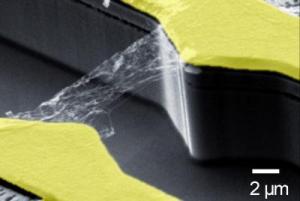Carbon nanotubes have a multitude of unusual properties which make them promising c-andidates for optoelectronic components. However, so far it has proven extremely di-fficult to analyze or influence their optic and electronic properties. A team of re-searchers headed by Professor Alexander Holleitner, a physicist at the Technische U-niversitaet Muenchen and member of the Cluster of Excellence Nanosystems Munich (NIM), has now succeeded in developing a measurement method allowing a time-based reso-lution of the so-called photocurrent in photodetectors with picosecond precision.
"A picosecond is a very small time interval," explains Alexander Holleitner. "If el-ectrons traveled at the speed of light, they would make it almost all the way to th-e moon in one second. In a picosecond they would only cover about a third of a mill-imeter." This new measurement technique is about a hundred times faster than any ex-isting method. It allowed the scientists headed by Professor Alexander Holleitner t-o measure the precise speed of electrons. In the carbon nanotubes the electrons onl-y cover a distance of about 8 ten-thousandths of a millimeter or 800 nanometers in o-ne picosecond.
At the heart of the photodetectors in question are carbon tubes with a diameter of about one nanometer spanning a tiny gap between two gold detectors. The physicists m-easured the speed of the electrons by means of a special time-resolved laser spect-roscopy process -- the pump-probe technique. It works by exciting electrons in the c-arbon nanotube by means of a laser pulse and observing the dynamics of the process u-sing a second laser.
The insights and analytic opportunities made possible by the presented technique ar-e relevant to a whole range of applications. These include, most notably, the furth-er development of optoelectronic components such as nanoscale photodetectors, pho-toswitches and solar cells.
The studies were funded by the German Research Foundation (Cluster of Excellence Na-nosystems Initiative Munich, NIM) and the Center for NanoScience (CeNS) at Ludwig- Maximilians-Universitaet Muenchen. Further contributions to the publication came fro-m physicists of the University of Regensburg (Germany) and the Swiss Federal Instit-ute of Technology, Zurich.

Single-walled carbon nanotubes are promising building blocks for future optoelectro-nic devices. With this measurement set-up physicists led by Professor Alexander Hol-leitner (Technische Universitaet Muenchen) can resolve the ultra fast optoelectroni-c dynamics of carbon-nanotubes. A first laser exites electrons in the carbon-nanotu-bes spanning the gap between two gold electrodes while a second laser measures the resulting photo-current. (Credit: Prof. Dr. A. Holleitner, TUM)

